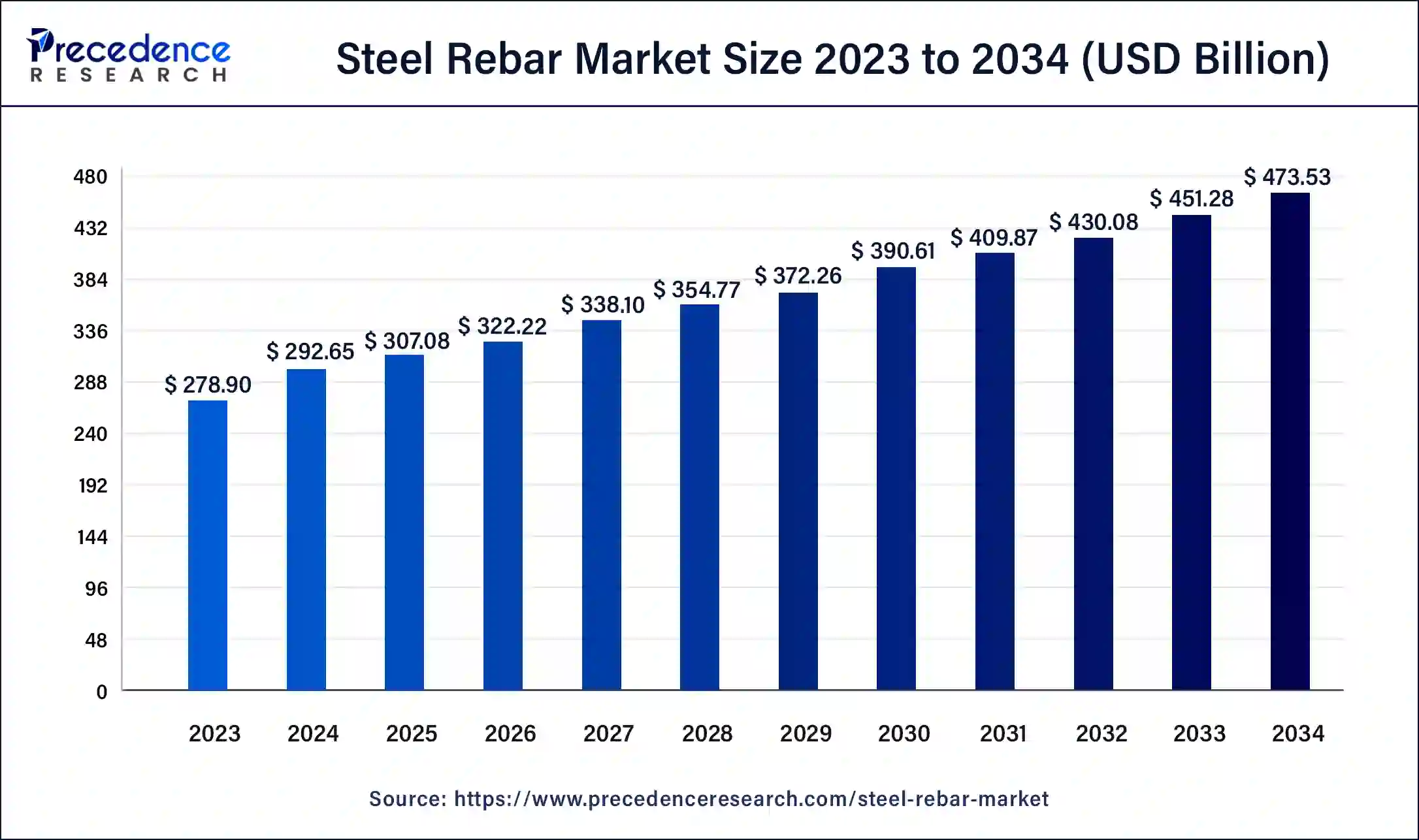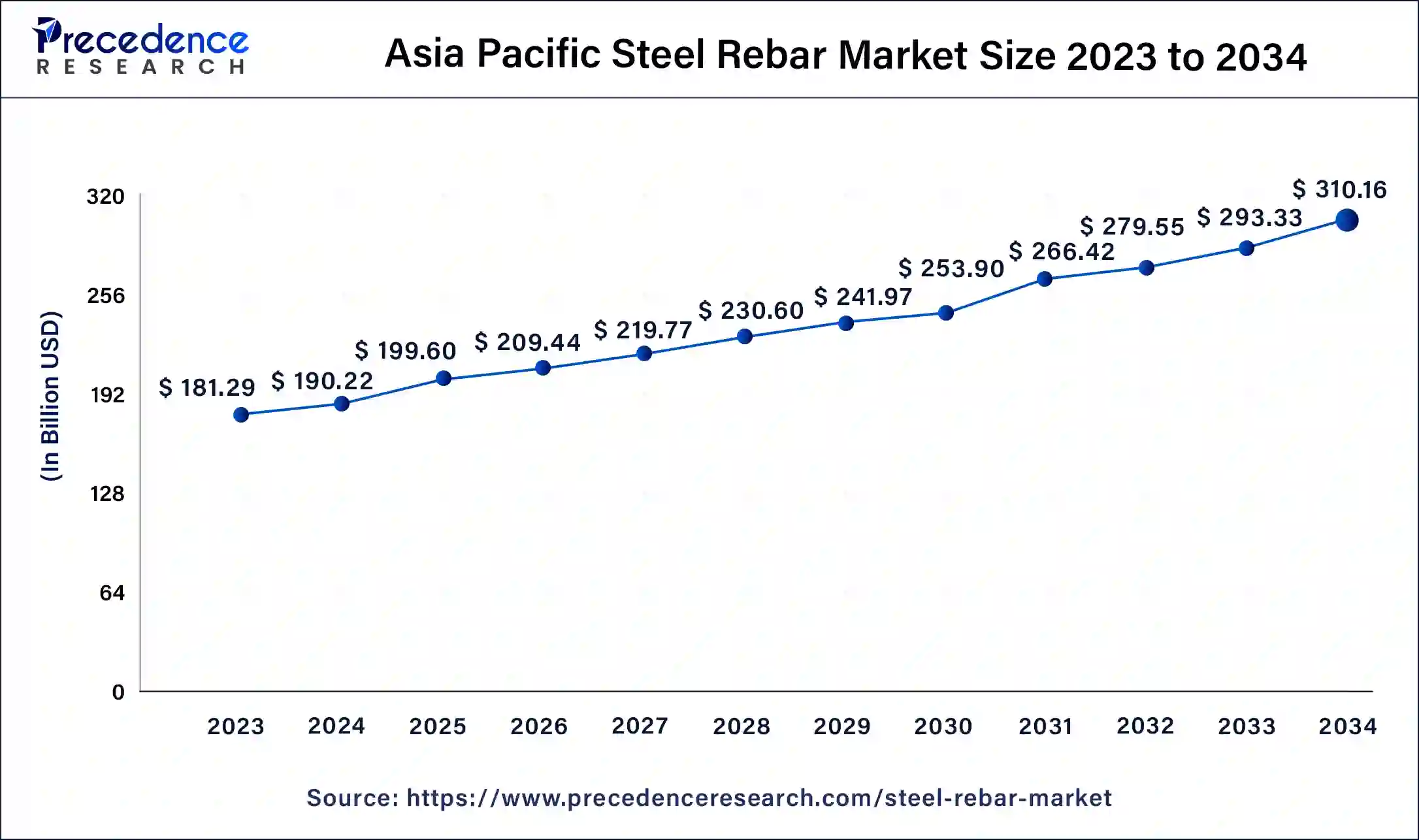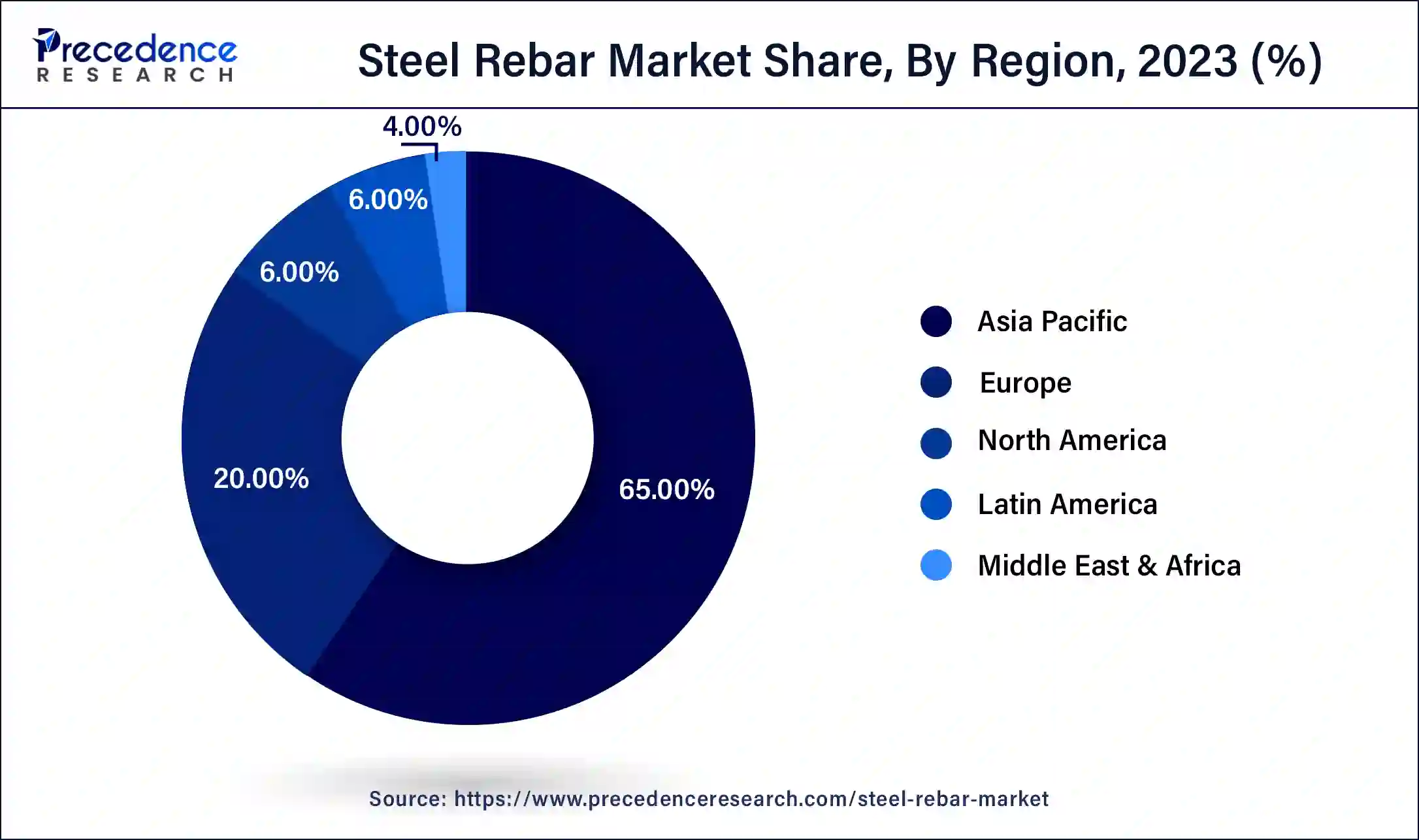September 2024
The global steel rebar market size was USD 278.90 billion in 2023, calculated at USD 292.65 billion in 2024 and is expected to be worth around USD 473.53 billion by 2034. The market is slated to expand at 4.93% CAGR from 2024 to 2034.
The global steel rebar market size is worth around USD 292.65 billion in 2024 and is anticipated to reach around USD 278.90 billion by 2034, growing at a CAGR of 4.93% over the forecast period 2024 to 2034. The steel rebar market growth is attributed to rising infrastructure investments globally.

The Asia Pacific steel rebar market size was exhibited at USD 181.29 billion in 2023 and is projected to be worth around USD 310.16 billion by 2034, poised to grow at a CAGR of 5.00% from 2024 to 2034.

Asia Pacific dominated the global steel rebar market in 2023 due to the high rate of development in infrastructure, mainly in developing countries, such as China and India, which were responsible for more than 60% of the region’s steel consumption. The two major programs launched by the Indian government, including the Smart Cities Mission and the Housing for All by 2022, are expected to increase the demand for steel rebar in residential and public infrastructure projects in the region in the coming years. Furthermore, the ready availability of raw materials, cheap labor, and high demand within the region are expected to fuel the market in this region.

North America is projected to host the fastest-growing steel rebar market in the coming years. Due to aging infrastructure, many of the bridges in America are over 50 years old, and therefore, this requires significant levels of repair and reconstruction work. As constructors use steel rebars for constructing bridges, there is a demand for steel rebars. The USD 1.2 trillion passed the U.S Infrastructure Investment and Jobs Act, which is expected to spur a wave of development in roads, bridges, and public transport systems. Moreover, the demand for green construction techniques and energy-efficient structures requires further growth in the market as the governments encourage a shift to sustainable structures.
The increasing need for robust and sustainable structures and strong construction activity in various regional markets will boost demand for the steel rebar market in the coming years. Reinforcing steel bars or steel bars used for structural concrete improves tensile stress in structures such as buildings, bridges, and major projects. Recent developments in the material options for construction that include epoxy-coated and corrosion-resistant rebar assure durability and, thus, minimal long-term maintenance costs. These factors are expected to pull the market forward in the coming years, especially given the staking demand for greener and more durable construction material alternatives.
Impact of Artificial Intelligence on the Steel Rebar Market
By implementing the use of artificial intelligence (AI) in manufacturing, manufacturers are able to keep track of the progress of production with fewer to no mistakes and less wastage. AI in demand forecasting enables appropriate changes to be made to output patterns, which eliminates the high costs associated with inventory. Furthermore, it is possible to recognize possible failures in pieces of equipment before they actually fail, thus reducing downtime and maintenance expenses.
| Report Coverage | Details |
| Market Size by 2034 | USD 473.53 Billion |
| Market Size in 2024 | USD 292.65 Billion |
| Market Growth Rate from 2024 to 2034 | CAGR of 4.93% |
| Largest Market | Asia Pacific |
| Base Year | 2023 |
| Forecast Period | 2024 to 2034 |
| Segments Covered | Type, Bar Size, Coatin, Process, End-user Sector, and Regions |
| Regions Covered | North America, Europe, Asia-Pacific, Latin America and Middle East & Africa |
Growing urbanization and infrastructure development
Growing urbanization, particularly in emerging economies, is anticipated to drive the demand for steel rebar in construction projects. The growing size of metropolitan areas and demands for housing, transport, and energy compel governments to embark on infrastructure spending. Growing incorporation of environmentally friendly construction materials also boosts this trend, as rebar is a durable material that caters to large structures, particularly in Asia Pacific and Middle Eastern countries. Moreover, the rapid growth of urbanization and infrastructure investments, which in turn are favorable for the development of the steel rebar market, especially in parts of the world that experience increased population densities and urbanization migration.
| Region | Projected Infrastructure Investment (USD trillion) | Urban Population Growth (%) | Investment Timeline |
| Global | 94 | 68 | 2040 |
| Asia Pacific | 50.76 | 60 | 2040 |
| India | 1.4 | 50 | 2019-2025 |
| Global | 68 | 2050 |
Availability of substitutes
The availability of substitutes is anticipated to impede the steel rebar market’s growth as alternative materials, such as fiber-reinforced polymers (FRP), continue gaining traction in the construction industry. FRP exhibits far better resistance to corrosion, excellent durability, and a high strength-to-weight ratio than steel rebar. It is gradually replacing the same in large projects related to building construction and other infrastructural development for durability. Furthermore, increasing awareness and development of sustainable construction materials in the construction industry has further given more preference to FRP.
Technological advancements
Ongoing advancement and development in novel steel manufacturing processes are expected to create immense opportunities for the players competing in the steel rebar market. Manufacturing systems through automation, machine learning, and smart manufacturing systems are likely to improve production and decrease costs. Other forms of manufacturing technologies, including integration with IoT, improve material management, cutting more than a fifth fraction of wastage, according to the World Economic Forum. Additionally, the increase in the popularity of steel rebars within industries is due to reduced production costs.
The deformed segment held a dominant presence in the steel rebar market in 2023 due to the increased population density and infrastructural developments in various regions, such as Asia Pacific and Latin America. High-strength materials are mostly used due to their being cheap and their longevity, especially in most commercial and industrial buildings where there is a high demand for strength since IT is a determinant of project longevity. Furthermore, reinforced concrete is the most common application of this type of rebar, and it is used in the construction of highways, bridges, extremely tall buildings, and other large structures.
The mild segment is expected to grow at the fastest rate in the steel rebar market during the forecast period of 2024 to 2034, owing to its ability to be easily formed. Its uses include small houses, roads, low rises, and stores. The growing trend of building affordable houses using mild reinforced steel throughout developing areas of Africa and certain regions of South Asia is likely to create demand for mild rebar. Furthermore, there has been an increase as infrastructural development projects have changed to green and cheaper materials for necessities, including structure formations.
The #4 segment accounted for a considerable share of the steel rebar market in 2023 due to its use in most of the homes and commercial buildings under construction. The #4 Bar, with a diameter of 1/2 inch, is especially popular because of the right proportion of strength and its lightness, making it ideal for reinforced concrete structures. The continuous rise in population and infrastructure development in construction projects fuels their demand.
The #5 segment is anticipated to grow with the highest CAGR in the steel rebar market during the studied years, owing to the increased use in larger structures, including bridges, highways, and industrial. The rising interest in durability and safety requirements within construction is likely to foster demand for the #5 Bar, as it has greater tensile strength. Additionally, the increased concern towards the use of sustainable construction materials is expected to spur this segment due to the effective utilization of important materials in large projects.
The plain carbon steel rebar segment led the global steel rebar market, due to its versatility and low cost in comparison with traditional construction materials applicable in different forms of construction, including residential, commercial, and infrastructural. Plain carbon steel rebar is the preferred type, as it has high tensile and corrosion strength. Moreover, the rising trend of construction projects, especially in the developing region, is expected to boost the demand for these types of rebar for construction activities.
The epoxy-coated steel rebar segment is projected to expand rapidly in the steel rebar market in the coming years, owing to the increased need for corrosion-resistant materials, especially in the construction sector. These structures are often built in regions that are battered in terms of weather and other conditions, including marine areas and industries. Compared with normal reinforcement steel bars, epoxy-coated rebar is rust or corrode-proof. This durability enhances, and the long-term maintenance costs also lower the structure. Moreover, the growing concern towards building structures and monolithic construction equipment, along with the implementation of stringent construction acts, will foster the growth of the epoxy-coated rebar market over the forecasted period, as it is preferred for expensive projects.
The oxygen steelmaking segment dominated the global steel rebar market in 2023. This process is preferred since lots of oxygen is utilized to decrease the carbon content from the iron ores to steel. The BOS process presents substantial cost synergies because the rates of production of the steel and the quality of steel allow for enormous-scale production of rebar in large quantities. Furthermore, there is an escalating rate by which infrastructural development and construction activities are required worldwide.
The electric arc furnace segment is projected to grow at the fastest rate in the steel rebar market in the future years, owing to the increase of focus on sustainability and recycling within the field of steel. EAF is an innovative technology in which scrap steel is used as the principal input material, thus using much less energy and emitting less CO2 than other conventional techniques. The trend towards environmentally conscious construction and manufacturing means that more EAF steel producers are expected to transition to the usage of rebar, especially for compliance with environmental laws. Additionally, the EAF process makes the production process short and beneficial in catering to the demands of sophisticated global manufacturers.
The infrastructure segment dominated the steel rebar market during the forecasting period due to the enormous government expenditure on public infrastructural constructs, such as roads, bridges, and transport systems. The continuous urban development and the appearance of new infrastructural development projects, along with the requirement of replacing aged reinforcement bars in multiple countries, foresees a continuous demand for rebar in this sector. Furthermore, enhancements in smart city processes and efficient construction and infrastructure industries are expected to boost the demand for steel bars in this sector.
The housing segment is projected grow rapidly in the steel rebar market in the future years, owing to the increase in demand for residential constructions facilitated by the growing population and increase in urbanization. The population demanding affordable houses, especially in the developing region, is projected to boost the consumption of steel rebar as builders look for tough materials, especially in construction projects. Furthermore, increased investment in the global housing market through government incentives for housing schemes and first-time home buyers.
Segments Covered in the Report
By Type
By Bar Size
By Coating
By Process
By End-user Sector
By Geography
For inquiries regarding discounts, bulk purchases, or customization requests, please contact us at sales@precedenceresearch.com
No cookie-cutter, only authentic analysis – take the 1st step to become a Precedence Research client
September 2024
January 2024
January 2025
November 2024